On Holy Thursday in the year 1519, Spanish ships landed on the shores of the Aztec state - at the height of today's Veracruz, Mexico. A day later - on Good Friday, April 22, 1519, the leader of the expedition, Hernán Cortés, went ashore. Emissaries of the Aztec ruler Moctezuma were waiting for him on the shore. They welcomed newcomers with an almost chronic dread. The sight of the hat with Cortés's feathers only made them more convinced that now the time had passed. Before them they have Quetzalcoatl himself - the Feathered Serpent - the greatest God of the Aztecs. You could not oppose such a person, you could not defeat him with any force ...
Four years later, Cortés finally conquered the mighty Aztec empire, bringing this extremely advanced civilization to an end. He did this with a squad of 500 men. With such a handful of dedicated soldiers, he set off deep into the great state, against Indian armies of thousands of warriors. How did his modest expedition take over a mighty empire? To this day, historians are puzzled over this. The stunning success of the Spaniards is not fully explained by the superiority in armaments, the skillful incitement of tribes subordinate to the Aztecs, or the smallpox epidemic that broke out a little later in the Indian state. Without one extremely strong element, the Spaniards would never have made it to the Aztec capital. Their expedition would be pacified while still on the coast.
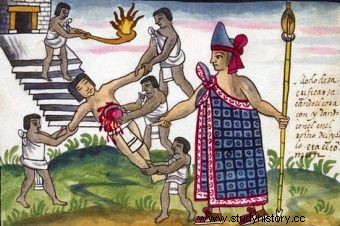
Why were the Aztecs defeated by the Spaniards?
This element was the powerful, overwhelming self-suggestion that the Aztecs fell victim to and especially their ruler and high priest, Montezuma. He was convinced that the bearded, fair-skinned visitors, "equipped" with strange monsters (the Indians did not know horses), were emissaries of Quetzalcoatl himself, the most important god in the Aztec pantheon . The arrival of the Feathered Serpent - not only the year the conquistadors arrived, but also the very day they came ashore - was announced in the Aztec calendar. He was for the Indians the most important body that defined their whole world.
"The year of one reed"
The calendar literally permeated the personal and group life of the Aztecs. It defined the divine meaning of each day. He spoke about when to make human blood sacrifices so as to appease the gods, and when to abstain from them. It defined fate and happiness. He spoke about the opportunities and threats in the following years. Through a set specific vibration each day of the year, he even defined the individual destiny of each newborn child. Following the calendar was imperative. The sun may have stopped rising, crops may have stopped growing, etc.
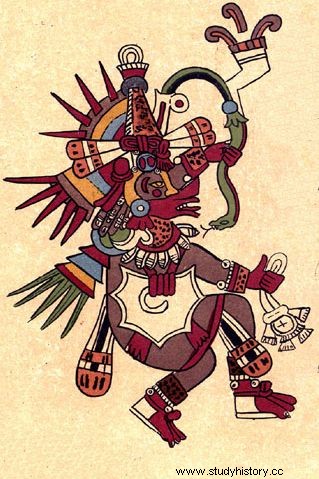
Quetzalcoatl was considered to be the co-creator of the world
In order to avoid a catastrophe in a strictly defined period of time, the gods had to be fed with blood . Otherwise - without the still beating, warm hearts, just torn from the chests of sacrificed people - the deities could destroy the world known to the Indians. Human sacrifice was especially demanded by Tezcatlipoca ("The Smoking Mirror") - one of the two most important Gods of the Aztec pantheon. This bloodthirsty deity gave them fire, was the god of providence and fate, as well as sin and darkness. In order to satisfy the "Smoking Mirror", the Aztecs had to invade neighboring tribes and kidnap their captives, who were later ritually killed.
The river of blood, the piles of flesh, the torn out intestines seemed to be endless. It is true that another god, and at the same time brother of the "Smoking Mirror" - that is Quetzalcoatl "Feather Serpent" - the teacher and protector of mankind - spoke out against human sacrifice, but the more aggressive Tezcatlipoca managed to chase him away.
On the coast near Tabasco, Quetzalcoatl boarded a magic raft and headed east. But before he sailed away, he made the prophecy:“I will return in the year of one reed, and I will restore my reign. Then there will be a time of great human suffering
- writes Maurice Collis, author of the book about the conquest of Mexico - "Cortés and Montezuma".
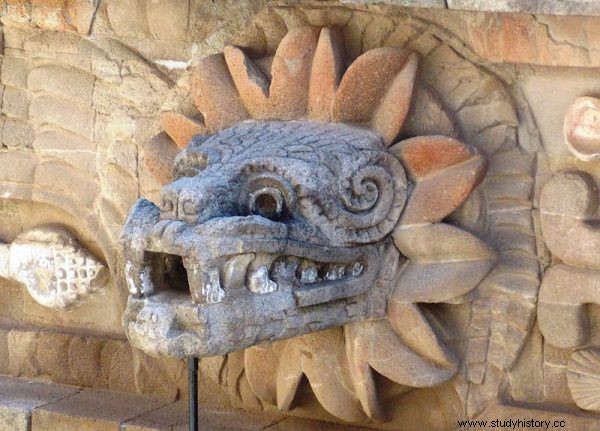
The head of the Feathered Serpent of Teotihuacan
The Aztecs looked to the return of Quetzalcoatl in each recurring "year of one reed". In 1363 (according to the Gregorian calendar) nothing special happened, and in 1467 as well. The next "year of one reed" was in 1519, when the ships of the Spaniards led by Cortés reached the shores of Mexico ...
Montezuma and his council were not sure how the god would return, but they guessed that since he had sailed on a magical raft from the port of the Gulf of Mexico to the east, he would come on some mysterious ship from that direction as well. Tradition passed on the appearance of Quetzalcoatl - very unusual in these areas:it was supposed to have white skin and a black beard
- Collis writes.
The prophecy of the deity's return fell on the extremely fertile ground, which was the mind and personality of Moctezuma - a ruler who places great emphasis on religion, prophecy and fortune-telling. He was surrounded by a garland of astrologers, seers, necromancers, etc. They had no good news for him:a series of signs indicated that something bad was going to happen in “the year of one reed”. A comet was seen in the night sky, volcanoes woke up, boiling water in Lake Mexico, a fire broke out in the temple of the sun god, and Moctezuma's sister fell into a coma in which she saw strange creatures bringing destruction to the country.
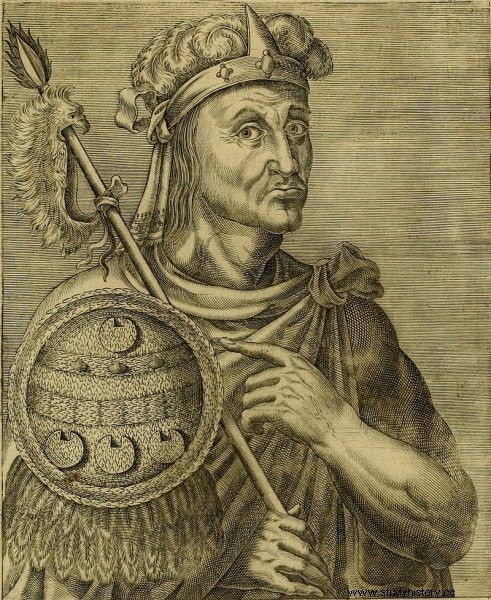
Montezuma II
Terrified, Moctezuma had to act. Already in 1518, he ordered to place watchmen on the entire coast, waiting for the arrival of the deity. Scouts soon began sending reports of great floating mounds or mighty floating towers that had landed on the shore where strange white people were climbing. They were members of Juan de Grijalva's expedition earlier than Cortés, who encountered members of the Maya tribe and later landed in Veracruz, where he first encountered the Aztecs. He announced that the Spaniards would be back soon.
Reports from the coast were thrilling the Aztec court and Moctezuma himself. Scouts carrying bad news were killed, but others returned with similar news. Apparently, Quetzalcoatl sent his messengers first, so that in the "year of one reed" he would come on his own.
His second coming…
Cortés reached the shores of the Aztec land on the exact day Quetzalcoatl was due to arrive.
This God was to reappear on his name day - on the 9th day of the wind. Cortés, after arriving in San Juan de Ulua on Holy Thursday (April 21) 1519, disembarked the next day, just on the 9th day of the wind. (...) he had a hat resembling the one supposedly worn by Quetzalcoatl and a black collar (because of Good Friday) - this was another coincidence:in the pictures in the magic books, Quetzalcoatl's clothing was black
- writes Maurice Collis.
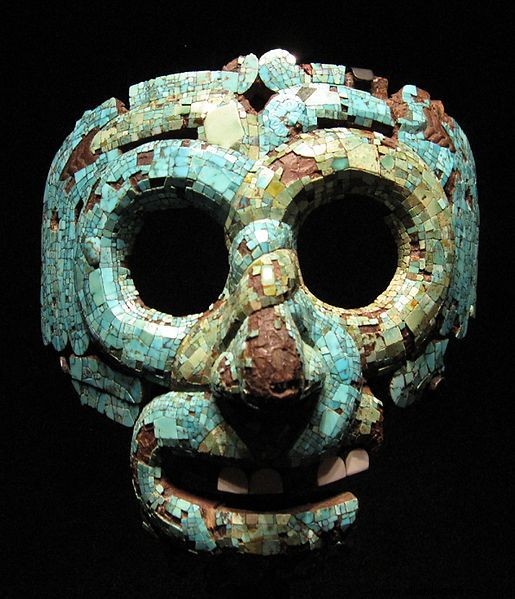
Mixteck Quetzalcoatl mask inlaid with jade from the British Museum in London
Can all of this be considered a coincidence? Certainly not by a manic astrology, very scared ruler. When intelligence began to report to Moctezuma about strange, unknown alien animals, about monsters puffing fire (cannons), weapons of steel and finally that Cortés, like his people, abhor human sacrifice, refuse to eat their meat nor food sprinkled with their blood , Montezuma became certain that now the time had come and that Quetzalcoatl himself had come, who did not support ritual murder and cannibalism and who would bring an end to his people.
Regardless of what happened, Montezuma could not use force against God! So, although he tried to dissuade the Spaniards (that is, Quetzalcoatl and his entourage) from the plan of visiting the capital Tenochtitlán with the help of his messengers and sorcerers, he was ultimately completely helpless.
The strangest thing is that Montezuma was strong enough to destroy Cortés's five hundred men, but he could not decide to issue such an order. His knowledge made him see the incarnation of a god in the conquistador. Prophecies, signs, astrology, heralds, fortune-telling, calendar, history - everything confirmed him in this opinion
- writes Maurice Collis.
Hernán Cortés quickly realized (thanks to la Malinche - his Indian partner / concubine who knew the Aztec language) that the locals saw him as a divine incarnation. However, he did not use this knowledge. He did see himself as a kind of divine messenger - only under the sign of Christ and the Holy Trinity - as indeed most of his people, who are wrongly attributed only to adventurous / plundering motivation. They were - as befits the place and spirit of the epoch - that is, Catholic Spain at the end of the Middle Ages and at the beginning of the Renaissance - deeply religious people who recognized their mission of bringing the truth about the only true, revealed and resurrected God - Jesus Christ ... immediately teaching the Indians about the Holy Trinity and the Blessed Virgin, installing images of the Mother of God in places of pagan Indian worship and distributing rosaries to the natives.
Today, the incredible coincidence related to the Cortés mission is not only surprising. A mysterious symbolic meaning emerges from it. The Conquistador indeed turned out to be an apocalypse and God's scourge to the Aztec world , the end of their civilization, and at the same time the beginning of a new spiritual order under the sign of the cross and Jesus Christ.
And Montezuma? Without a fight, he "bred" a viper on his chest. The Spaniards, strengthened by the allied Indian troops previously invaded by the Aztecs, reached the capital, where he voluntarily gave them first the royal chambers and then power. Perhaps at last he realized that he had only a human in front of him and not a deity, but that irrational fear was still paralyzing him. He was eventually killed in the rebellion against the Spaniards, killed at the hands of his own subjects.
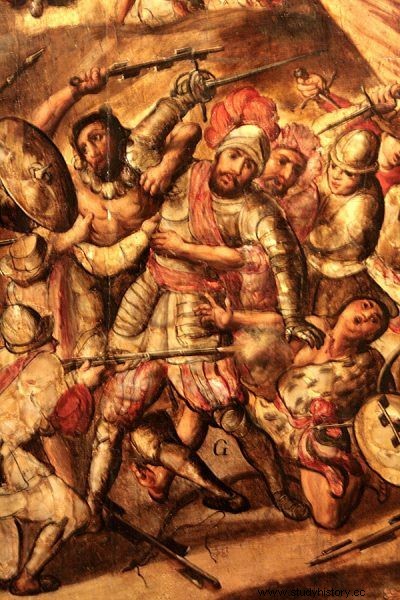
During the siege of Tenochtitlan Cortés was wounded and almost captured by the Aztecs
Soon after, the Aztecs organized a bloody slaughter for the conquistadors during the so-called La Noche Triste (tragic night), setting a trap for them in Tenochtitlan. The vast majority of the newcomers died, many of them having their hearts torn out on a sacrificial stone. But it was of no avail. The end of the Aztec world was nearing. An epidemic of smallpox, an unknown disease among Indians, decimated their ranks. Cortés returned to this, finally conquering Tenochtitlan on August 13, 1521. After breaking into the capital, the Spaniards and their Indians allied with them plundered the city and murdered the inhabitants for four days.
It was the end of the Aztec world. Quetzalcoatl's prophecy has come true. A white bearded god, he came from the east, bringing fire and destruction. After him, there were no human sacrifices. There was no such need. Catholic missionaries explained to the Indians that Jesus Christ had already died in sacrifice on the cross for all people in the world ...
